Abstract
Smooth pursuit and saccadic components of foveal visual tracking as well as more involuntary ocular movements of optokinetic (o.k.n.) and vestibular nystagmus slow phase components were investigated in man, with particular attention given to their possible input-adaptive or predictive behaviour. Each component in question was isolated from the eye movement records through a computer-aided procedure. The frequency response method was used with sinusoidal (predictable) and pseudo-random (unpredictable) stimuli. When the target motion was pseudo-random, the frequency response of pursuit eye movements revealed a large phase lead (up to about 90 degrees) at low stimulus frequencies. It is possible to interpret this result as a predictive effect, even though the stimulation was pseudo-random and thus 'unpredictable'. The pseudo-random-input frequency response intrinsic to the saccadic system was estimated in an indirect way from the pursuit and composite (pursuit + saccade) frequency response data. The result was fitted well by a servo-mechanism model, which has a simple anticipatory mechanism to compensate for the inherent neuromuscular saccadic delay by utilizing the retinal slip velocity signal. The o.k.n. slow phase also exhibited a predictive effect with sinusoidal inputs; however, pseudo-random stimuli did not produce such phase lead as found in the pursuit case. The vestibular nystagmus slow phase showed no noticeable sign of prediction in the frequency range examined (0 approximately 0.7 Hz), in contrast to the results of the visually driven eye movements (i.e. saccade, pursuit and o.k.n. slow phase) at comparable stimulus frequencies.
Full text
PDF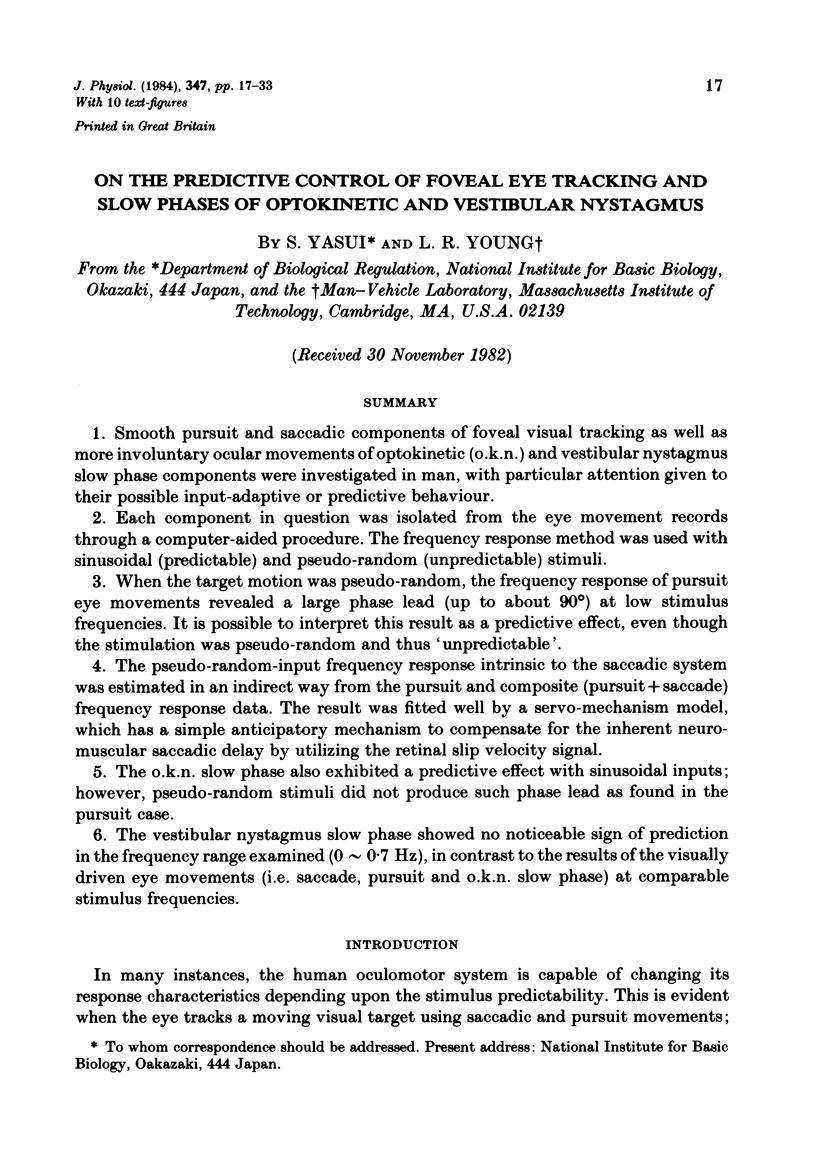
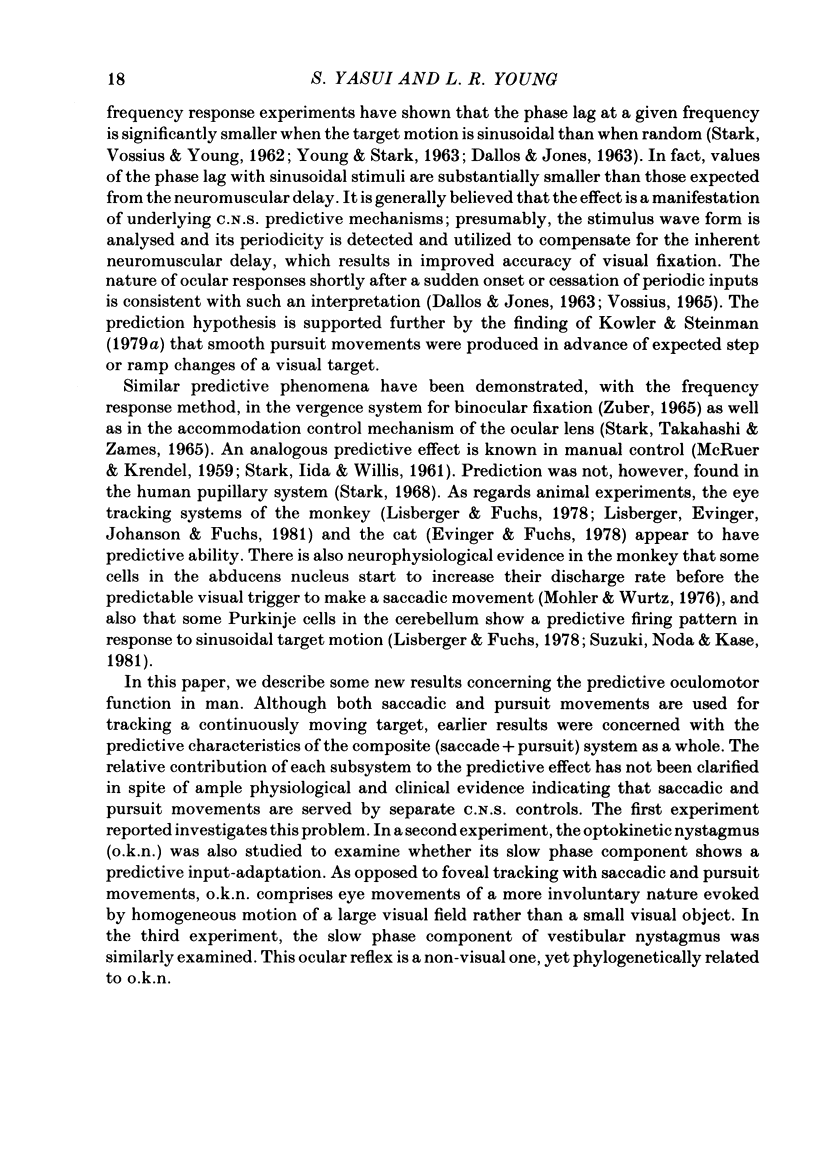
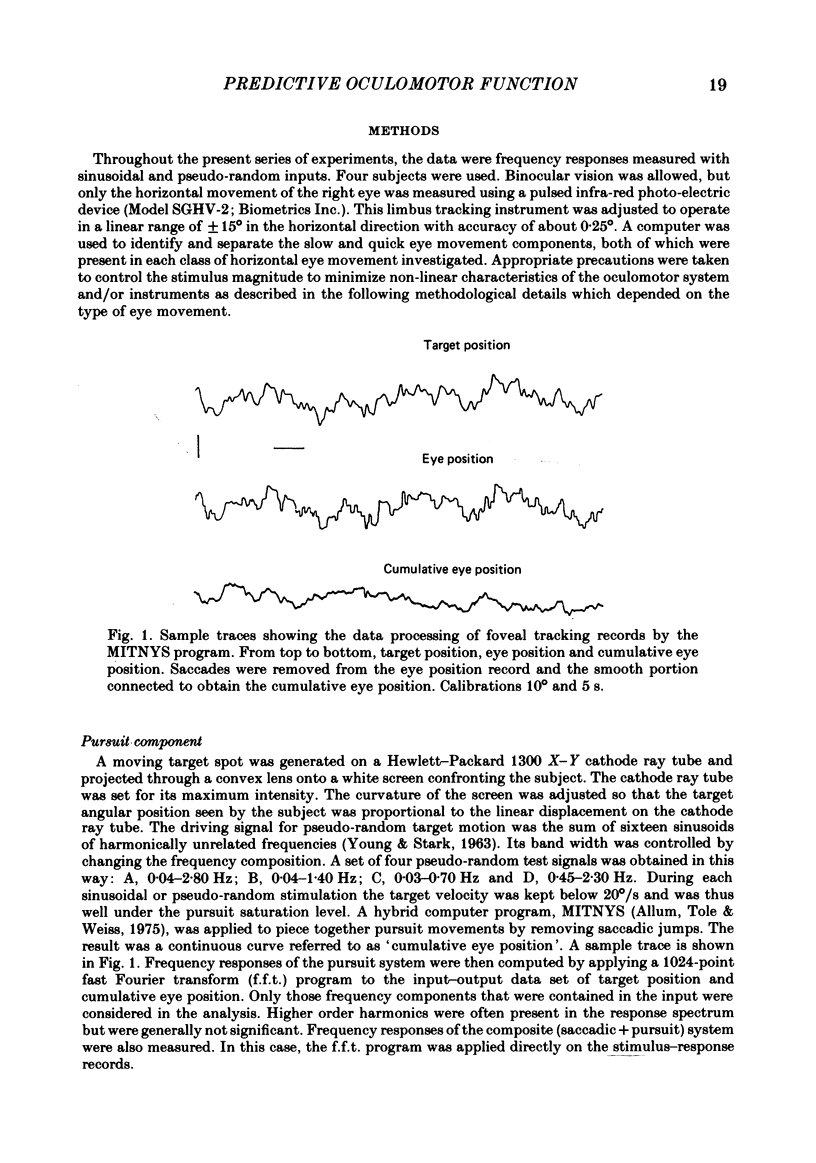

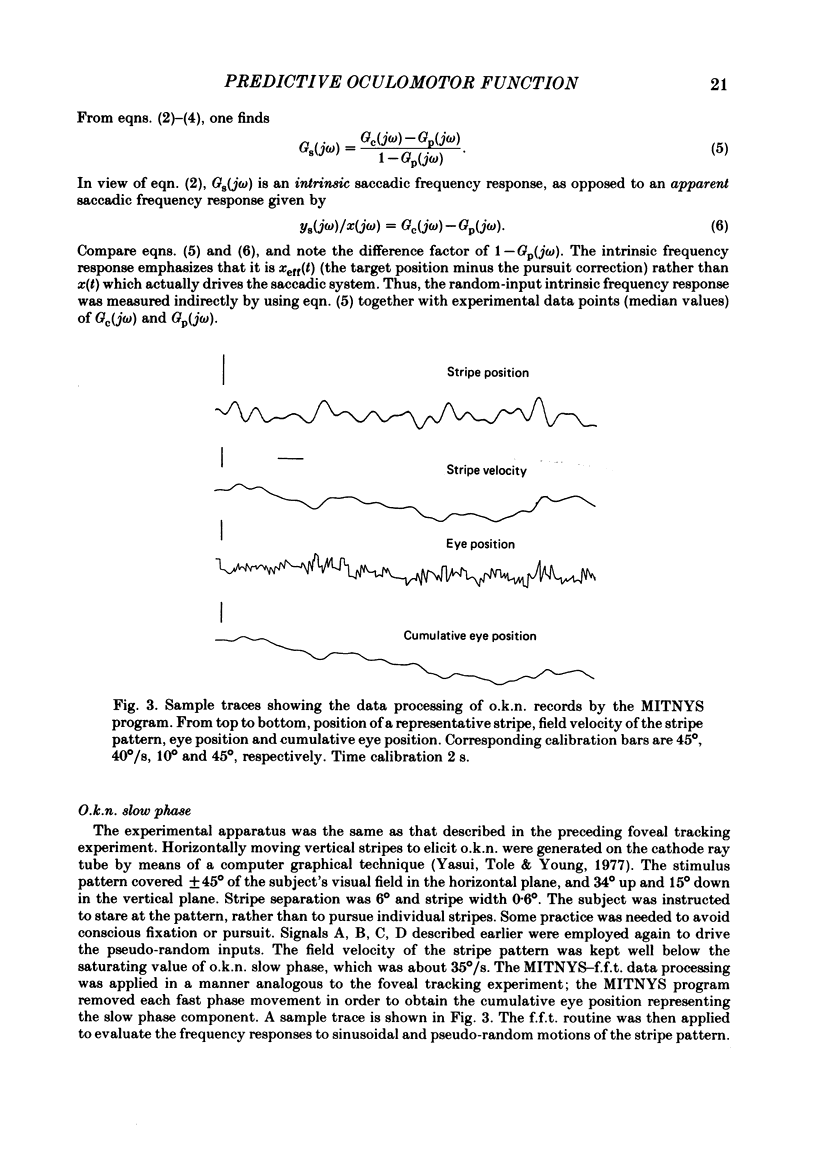
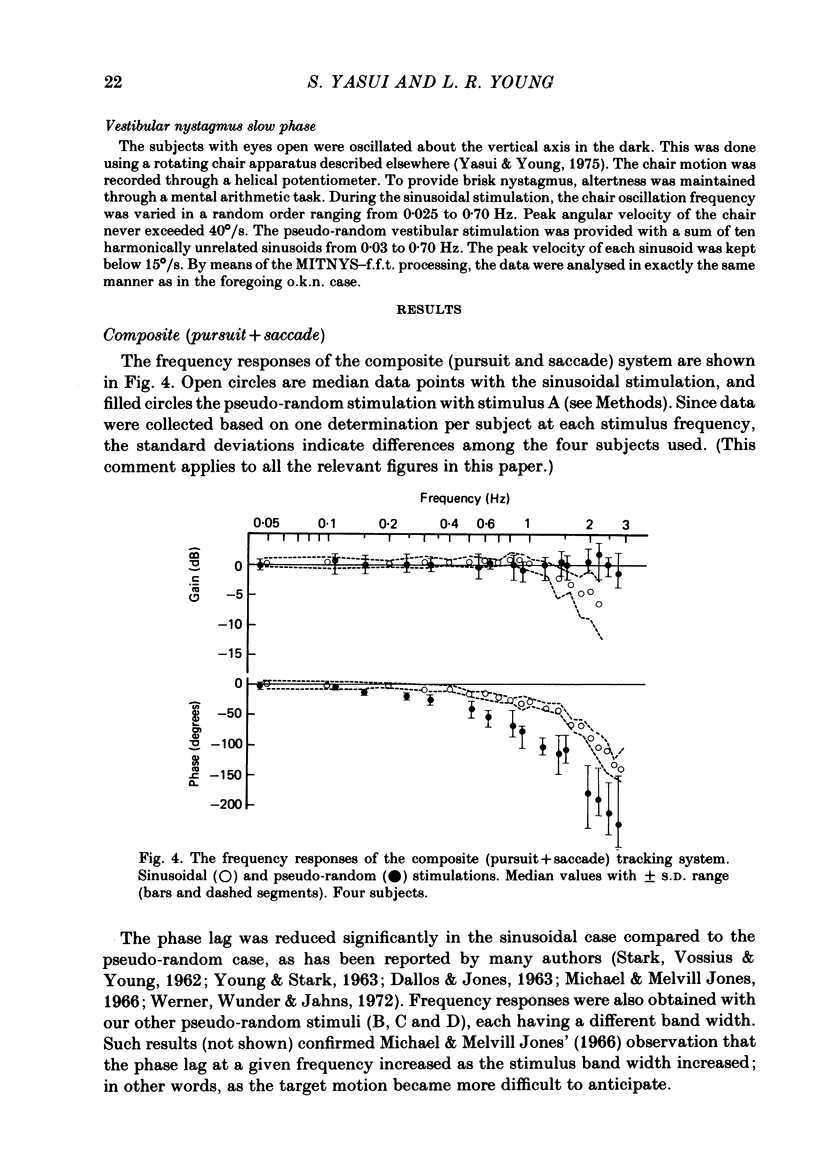
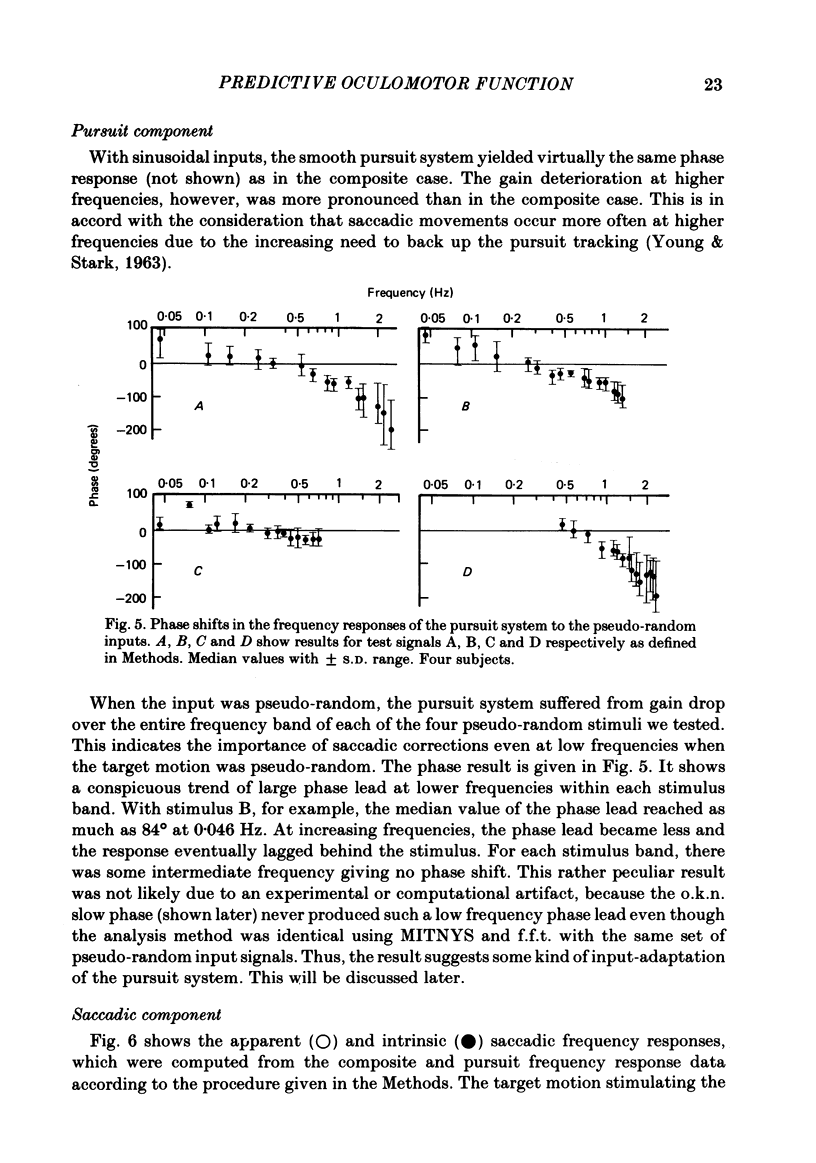
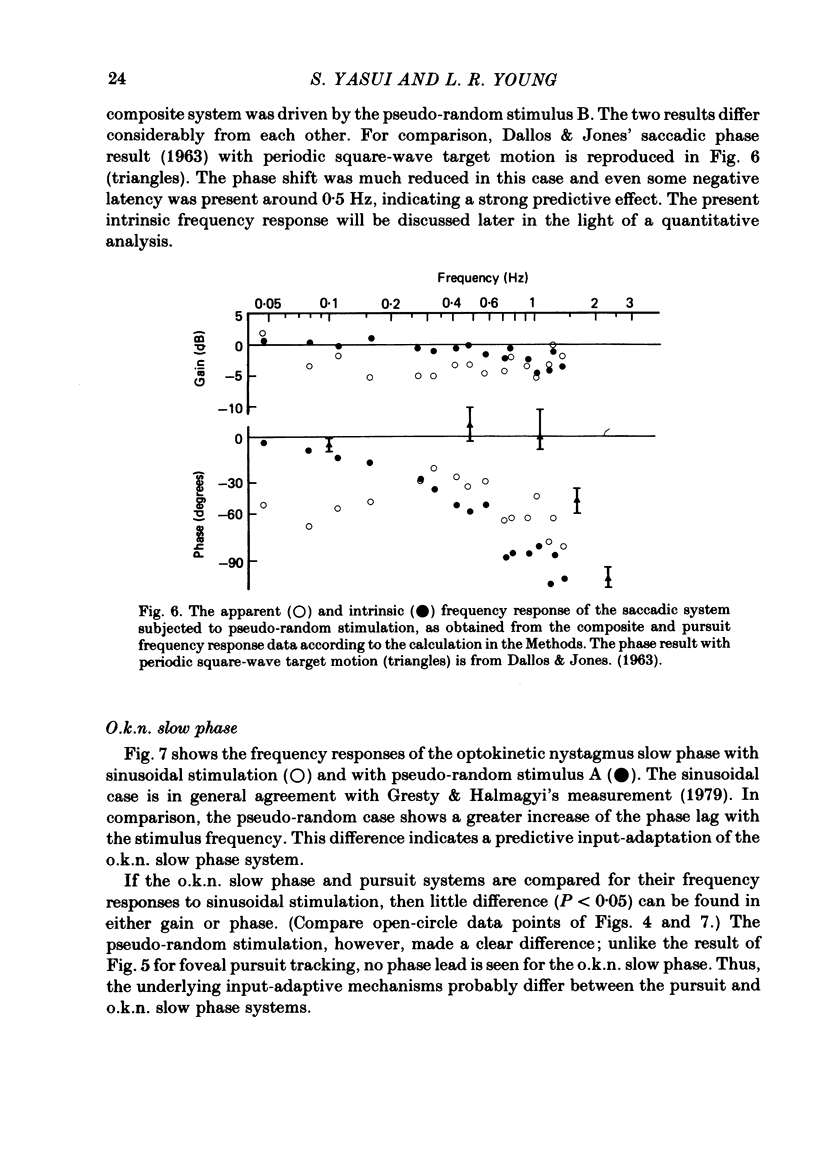


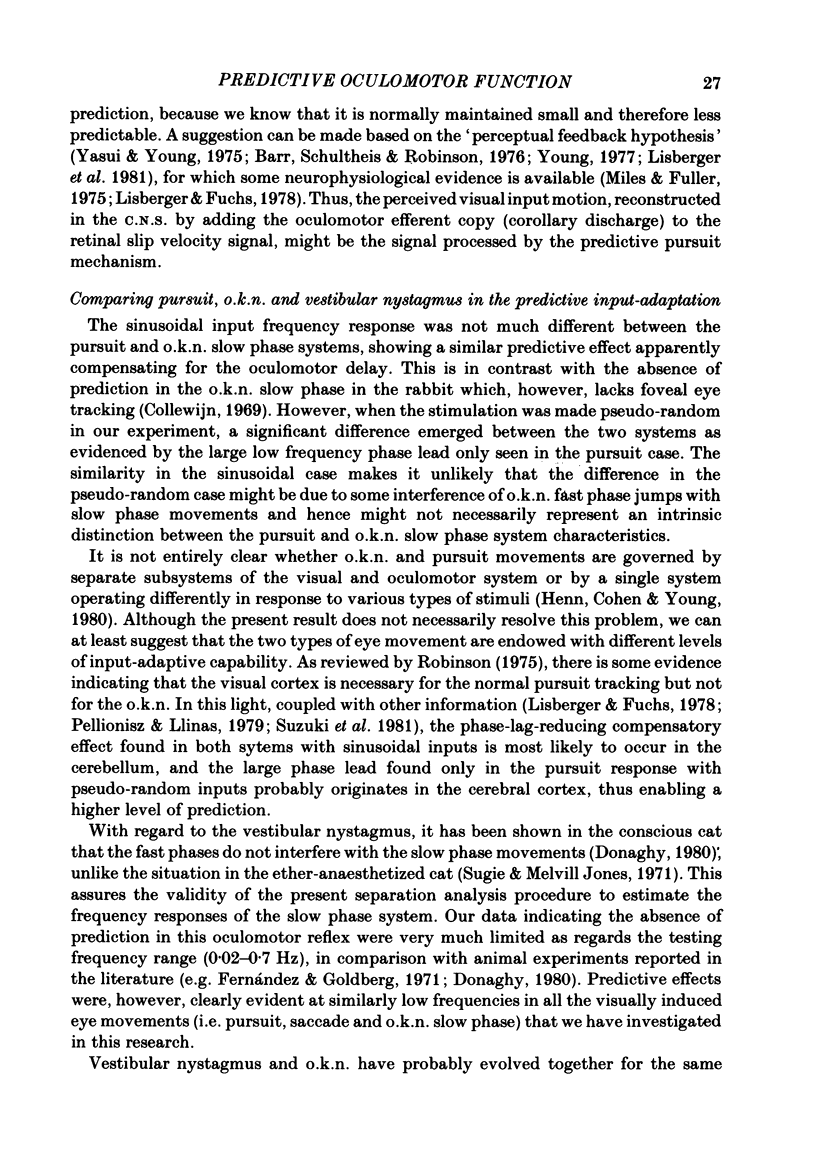


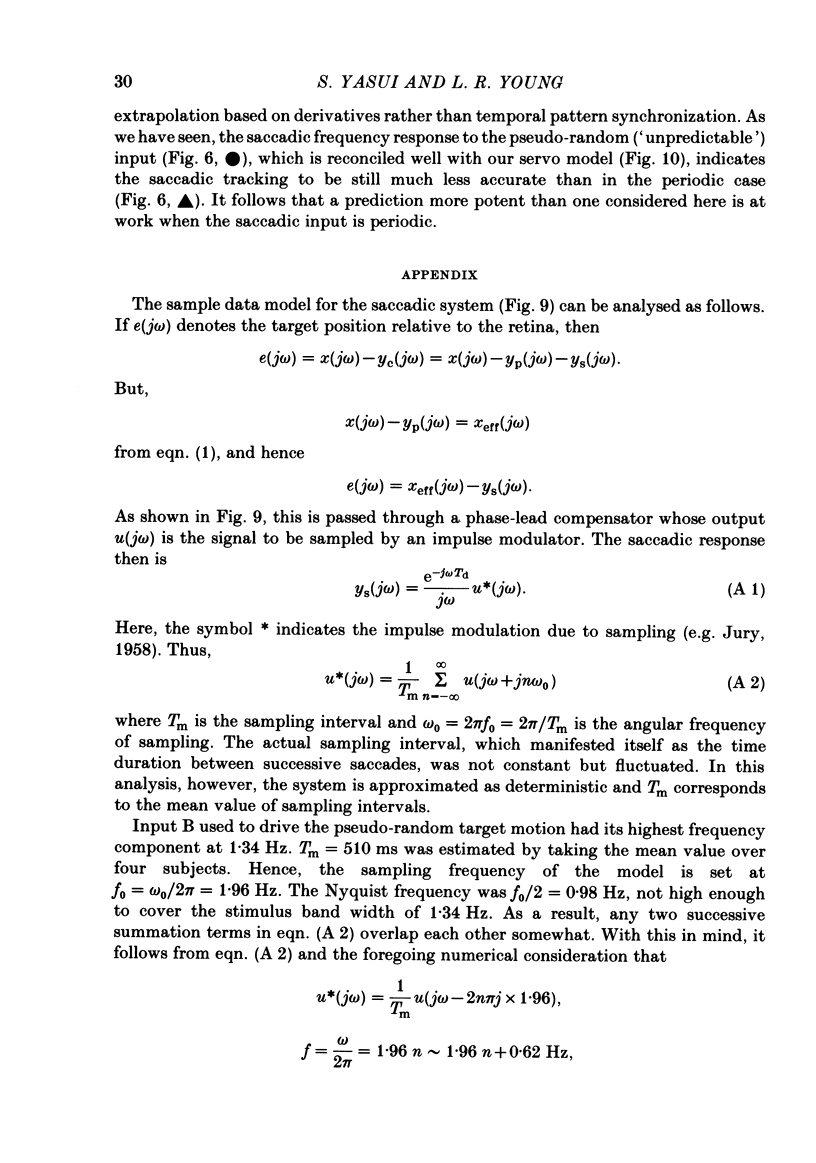



Selected References
These references are in PubMed. This may not be the complete list of references from this article.
- Allum J. H., Tole J. R., Weiss A. D. MITNYS-II--a digital program for on-line analysis of nystagmus. IEEE Trans Biomed Eng. 1975 May;22(3):196–202. doi: 10.1109/tbme.1975.324559. [DOI] [PubMed] [Google Scholar]
- Barr C. C., Schultheis L. W., Robinson D. A. Voluntary, non-visual control of the human vestibulo-ocular reflex. Acta Otolaryngol. 1976 May-Jun;81(5-6):365–375. doi: 10.3109/00016487609107490. [DOI] [PubMed] [Google Scholar]
- Collewijn H. Optokinetic eye movements in the rabbit: input-output relations. Vision Res. 1969 Jan;9(1):117–132. doi: 10.1016/0042-6989(69)90035-2. [DOI] [PubMed] [Google Scholar]
- Donaghy M. The cat's vestibulo-ocular reflex. J Physiol. 1980 Mar;300:337–351. doi: 10.1113/jphysiol.1980.sp013165. [DOI] [PMC free article] [PubMed] [Google Scholar]
- Evinger C., Fuchs A. F. Saccadic, smooth pursuit, and optokinetic eye movements of the trained cat. J Physiol. 1978 Dec;285:209–229. doi: 10.1113/jphysiol.1978.sp012568. [DOI] [PMC free article] [PubMed] [Google Scholar]
- Fernandez C., Goldberg J. M. Physiology of peripheral neurons innervating semicircular canals of the squirrel monkey. II. Response to sinusoidal stimulation and dynamics of peripheral vestibular system. J Neurophysiol. 1971 Jul;34(4):661–675. doi: 10.1152/jn.1971.34.4.661. [DOI] [PubMed] [Google Scholar]
- Gresty M., Halmagyi M. Following eye movements on the absence of central vision. Acta Otolaryngol. 1979 May-Jun;87(5-6):477–483. doi: 10.3109/00016487909126455. [DOI] [PubMed] [Google Scholar]
- Henn V., Young L. R., Finley C. Vestibular nucleus units in alert monkeys are also influenced by moving visual fields. Brain Res. 1974 May 10;71(1):144–149. doi: 10.1016/0006-8993(74)90198-x. [DOI] [PubMed] [Google Scholar]
- Koenig E., Allum J. H., Dichgans J. Visual-vestibular interaction upon nystagmus slow phase velocity in man. Acta Otolaryngol. 1978 May-Jun;85(5-6):397–410. doi: 10.3109/00016487809121468. [DOI] [PubMed] [Google Scholar]
- Kowler E., Steinman R. M. The effect of expectations on slow oculomotor control. I. Periodic target steps. Vision Res. 1979;19(6):619–632. doi: 10.1016/0042-6989(79)90238-4. [DOI] [PubMed] [Google Scholar]
- Kowler E., Steinman R. M. The effect of expectations on slow oculomotor control. II. Single target displacements. Vision Res. 1979;19(6):633–646. doi: 10.1016/0042-6989(79)90239-6. [DOI] [PubMed] [Google Scholar]
- Lisberger S. G., Evinger C., Johanson G. W., Fuchs A. F. Relationship between eye acceleration and retinal image velocity during foveal smooth pursuit in man and monkey. J Neurophysiol. 1981 Aug;46(2):229–249. doi: 10.1152/jn.1981.46.2.229. [DOI] [PubMed] [Google Scholar]
- Lisberger S. G., Fuchs A. F. Role of primate flocculus during rapid behavioral modification of vestibuloocular reflex. I. Purkinje cell activity during visually guided horizontal smooth-pursuit eye movements and passive head rotation. J Neurophysiol. 1978 May;41(3):733–763. doi: 10.1152/jn.1978.41.3.733. [DOI] [PubMed] [Google Scholar]
- Michael J. A., Jones G. M. Dependence of visual tracking capability upon stimulus predictability. Vision Res. 1966 Dec;6(12):707–716. doi: 10.1016/0042-6989(66)90082-4. [DOI] [PubMed] [Google Scholar]
- Miles F. A., Fuller J. H. Visual tracking and the primate flocculus. Science. 1975 Sep 19;189(4207):1000–1002. doi: 10.1126/science.1083068. [DOI] [PubMed] [Google Scholar]
- Mohler C. W., Wurtz R. H. Organization of monkey superior colliculus: intermediate layer cells discharging before eye movements. J Neurophysiol. 1976 Jul;39(4):722–744. doi: 10.1152/jn.1976.39.4.722. [DOI] [PubMed] [Google Scholar]
- Pellionisz A., Llinás R. Brain modeling by tensor network theory and computer simulation. The cerebellum: distributed processor for predictive coordination. Neuroscience. 1979;4(3):323–348. doi: 10.1016/0306-4522(79)90097-6. [DOI] [PubMed] [Google Scholar]
- RASHBASS C. The relationship between saccadic and smooth tracking eye movements. J Physiol. 1961 Dec;159:326–338. doi: 10.1113/jphysiol.1961.sp006811. [DOI] [PMC free article] [PubMed] [Google Scholar]
- Stark L., Iida M., Willis P. A. Dynamic Characteristics of the Motor Coordination System in Man. Biophys J. 1961 Mar;1(4):279–300. doi: 10.1016/s0006-3495(61)86889-6. [DOI] [PMC free article] [PubMed] [Google Scholar]
- Suzuki D. A., Noda H., Kase M. Visual and pursuit eye movement-related activity in posterior vermis of monkey cerebellum. J Neurophysiol. 1981 Nov;46(5):1120–1139. doi: 10.1152/jn.1981.46.5.1120. [DOI] [PubMed] [Google Scholar]
- WESTHEIMER G. Mechanism of saccadic eye movements. AMA Arch Ophthalmol. 1954 Nov;52(5):710–724. doi: 10.1001/archopht.1954.00920050716006. [DOI] [PubMed] [Google Scholar]
- Werner J., Wunder R., Jahns R. Untersuchungen zur Linearität des okulomotorischen Systems. Kybernetik. 1972 Aug;11(2):112–117. [PubMed] [Google Scholar]
- Yasui S., Tole J. R., Young L. R. A fast-reacting and versatile optokinetic stimulus pattern by computer graphics with application examples. IEEE Trans Biomed Eng. 1979 Mar;26(3):164–166. doi: 10.1109/tbme.1979.326386. [DOI] [PubMed] [Google Scholar]
- Yasui S., Young L. R. Perceived visual motion as effective stimulus to pursuit eye movement system. Science. 1975 Nov 28;190(4217):906–908. doi: 10.1126/science.1188373. [DOI] [PubMed] [Google Scholar]


